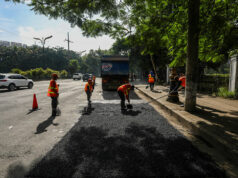Bringing life to broken parts
BROKEN bits of fishing boats drift on the sea before making landfall on the beach in Panglao, Bohol. The bangka are used for transportation between islands, by fishermen, and people taking leisure trips. As time goes by, parts of the fishing boats wear out and come off, some after rainy season storms.
Retired Swiss diplomat Jürg Casserini walks along the shoreline and collects the pieces — often sporting sun-faded numbers and letters — in a large bag, before he returns home and the real work begins.
Jürg Walter Casserini was born and raised in Thun, Switzerland. At an early age, he worked at the OCDE Swiss Delegation while taking further studies in Paris. Upon his return to Switzerland, he joined the Ministry of Foreign Affairs. His final posting was Deputy Head of Mission at the Swiss Embassy in Manila from 2009 to 2013.
After his retirement, he and his wife settled in the Philippines, travelling back and forth between Bohol and Manila.
A NEW PURPOSE
In Bohol, Mr. Casserini built a small studio where he creates sculptures, collages, and paintings.
He had been exposed to art as a young boy — his father owned a lithography and offset printing company in Thun called Stein und Offsetdruckerei Casserini & Son where he was exposed to the printmaking process.
Instead of taking over his father’s business, hed decided to pursue a career as a diplomat. It was only after retirement that he began creating original works.
“When I started, I saw so many fishermen’s boats, their broken parts floating in the sea, floating to the shore and back and forth,” Mr. Casserini told BusinessWorld in an interview over lunch in Makati City in early March before the COVID-19 lockdown.
After collecting the pieces, he said, “I clean them very carefully [with water and a small brush] because they are full of sand, seaweed, and shells. Then, I let them dry in the sun for weeks.”
Once the pieces of wood are dry, he takes a look at what he has — how much there is of a color and a size — and puts them together in a collage. Once satisfied, Mr. Casserini takes a photo on his phone to remember the composition. He then lets the work rest, leaves the work station, and keeps busy with other activities.
Upon returning to the studio, he looks at the works which he rarely rearranges since he is usually satisfied. “Maybe, I change a piece but I do not change many things,” he said.
“I [then] buy plywood, cut them, use it as a base for the bangka [parts] and glue them together in a collage.”
Mr. Casserini’s latest exhibit, titled The Bangka series, showcased 33 works at the Bamboo Organ Church in Las Piñas where he was the featured visual artist at 45th Bamboo Organ Festival in February.
“I never paint. I never retouch. Sometimes, wood is washed out. Sometimes the colors are not strong,” he noted. “I want to preserve the piece like how I found it on the beach — but cleaned.”
“Behind each piece is a story. But I do not know it, because the piece has been broken,” he said. “I wanted to bring back the fisherman’s boat in a piece of art.”
For more information on Jürg Casserini’s artworks, call 0917-819-5003, e-mail info@dare2art.com, or visit www.dare2art.com, and www.facebook.com/dare2art. — Michelle Anne P. Soliman



